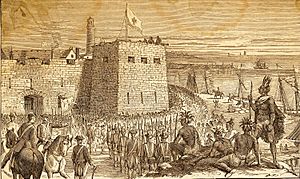Battle of Fort Bull facts for kids
Quick facts for kids Battle of Fort Bull |
|||||||
|---|---|---|---|---|---|---|---|
| Part of the French and Indian War | |||||||
|
|||||||
| Belligerents | |||||||
| Commanders and leaders | |||||||
| Chaussegros de Léry Collière |
William Bull † | ||||||
| Strength | |||||||
| 84 Troupes de la Marine 166 Canadian militia 90 Iroquois 20 Huron |
111 regulars | ||||||
| Casualties and losses | |||||||
| 1 dead 2 wounded |
76 dead 35 taken prisoner |
||||||
The Battle of Fort Bull was a surprise attack by French forces on a British fort called Fort Bull on March 27, 1756. This battle happened early in the French and Indian War, a big conflict between France and Britain in North America. Fort Bull was important because it protected a key water route that connected Albany, New York to Lake Ontario using the Mohawk River.
Lieutenant Gaspard-Joseph Chaussegros de Léry led the French attack. His group included French soldiers, Canadian militia, and Native American allies. They snuck up close to the fort, hidden by trees. Léry ordered a charge with bayonets. The attackers shot through small openings in the fort walls. Léry asked the British to surrender many times. Finally, the fort gate was broken down. The French and Native Americans rushed in, killing many defenders. The French soldiers took what they could and then set the fort's gunpowder storage on fire. Fort Bull was completely burned down.
Contents
Why Fort Bull Was Important
Fort Oswego, built by the British in the 1720s, was on the south side of Lake Ontario. The French called this "Lac de Frontenac." The French saw Fort Oswego as a big threat. They had controlled the Great Lakes and the valuable fur trade there. They wanted to keep the Great Lakes for themselves.
For a while, France and Britain tried to stay peaceful. But by the mid-1700s, they were at war again. The French and Indian War started in North America in 1754.
After some British plans failed in 1755, they set up a chain of forts. These forts were along the Mohawk River waterway. This route connected the Hudson River to Lake Ontario. Fort Oswego was at the end of this chain and needed supplies from the other forts.
Two forts were key to this supply line: Fort Williams and Fort Bull. They were located at the Oneida Carry. This was a section of land between one and six miles long. It connected the Mohawk River to Wood Creek. Wood Creek flowed into Oneida Lake, which led to the Oswego River and then Lake Ontario. The Mohawk River flowed into the Hudson River, which went to the Atlantic Ocean.
Fort Williams was larger. Fort Bull was smaller, mostly a palisade (a fence of strong wooden stakes) around storage buildings. It held many military supplies, like gunpowder and ammunition. These supplies were meant for British campaigns in 1756. Soldiers from Shirley's Regiment guarded Fort Bull.
French Plans to Attack

In late 1755, French leaders in Canada heard about the British building two supply houses at the Oneida Carrying Place. The Marquis de Vaudreuil, who was the Governor-General of New France, hired a spy. This spy was an Oswegatchie chief named Ou8atory. He was related to some Oneida clan mothers. He found out that the British were storing weapons, ammunition, and boats there. They were getting ready for an attack in the spring.
In early 1756, French military leaders decided to attack the British supply line. They wanted to strike before the British could launch their own attack. The French worried that the British would attack their forts, like Fort Niagara and Fort Frontenac, before French help could arrive.
Vaudreuil chose Lieutenant Gaspard-Joseph Chaussegros de Léry to lead the attack. Léry was part of the Troupes de la Marine. These were French soldiers who served in the colonies. Many of their officers were born in Canada and knew how to fight in the wilderness. They were good at combining European military training with Native American fighting styles.
The French also had Canadian militiamen. These were ordinary Canadian men who had to serve in the military. They were skilled hunters and knew the frontier well.
Many Iroquois people had become Catholic and lived near Montréal. They were called the Canadian Iroquois. They were allies of the French. The French needed their help to guide them through the land. The Canadian Iroquois were very careful about fighting. They wanted to take prisoners without losing their own people. Attacking a fort was very risky for them.
The March to Fort Bull
The Canadian Iroquois chiefs were not sure about the French plan for a winter attack. One Mohawk chief, Missakin, was convinced to join only after Léry promised him things in the name of Governor Vaudreuil.
On February 29, 1756, Léry's force left Montréal. It included Troupes de la Marine, French-Canadian militiamen, and Canadian Iroquois warriors. As they marched, more Iroquois joined. Léry promised them they would only fight the British, not other Iroquois.
On March 12, a group of men left Fort de La Présentation. They began their journey toward the Oneida Carry. Léry's force had 84 Troupes de la Marine soldiers. It also included 111 Canadian militiamen and 110 Native Americans. Most of the Native Americans were Iroquois, but some were Hurons.
On March 13, an Oswegatchie traveler told the Canadian Iroquois about the British forts. This made the Iroquois demand a stop. They did not want to attack forts because it was too dangerous. They preferred to raid British settlements instead. Léry insisted they follow his orders. Many Native Americans left and went home. After almost two weeks of difficult winter travel, the remaining force reached the Oneida Carry on March 24.
The Battle Begins
During the winter, the British soldiers at Fort Bull and Fort Williams had little food. Many were sick. On March 12, Sir William Johnson, 1st Baronet, a British leader, heard a rumor about a French force coming. He called up about 1,000 New York militiamen. But he sent them home three days later when he heard it was a false alarm. The British at Fort Bull did not know a French force was actually on its way.
On March 26, the French and Native American force was very close to the Oneida Carrying Place. Early on March 27, the Canadian Iroquois ambushed a British wagon train. They captured 9 wagons and 10 men. The French had not eaten for two days, so this food was very welcome. One British wagon driver escaped and rode to Fort Williams.
The Canadian Iroquois felt their mission was complete. They had fought the enemy, taken prisoners, and gotten supplies without losses. Most wanted to go home. They told Léry that attacking Fort Bull was "irrational" and would cause too many deaths. They said, "if I absolutely wanted to die, I was the master of the French, but they were not going to follow me." After much talk, 30 Iroquois agreed to join the attack. They joined 259 French soldiers and Canadian militiamen.
Léry learned from the prisoners that Fort Bull had weak defenses. He decided to attack right away on March 27. He had no cannons, so he had to try a surprise storming. Fort Bull had 25 soldiers, 34 carpenters and boatmen, and three women.
Around 11 AM, the French and Native Americans quietly approached Fort Bull. But the Iroquois gave a war cry, which alerted the British. The fort's defenders quickly closed the gate. Léry wrote that the gate was stronger than he thought. Only six Iroquois stayed with Léry. The others chased six Englishmen who could not get into the fort.
The attackers fired through small openings in the fort walls. The British threw rocks and grenades over the walls. French militiamen tried to chop through the wooden walls with tomahawks. The Troupes de la Marine used axes to try to break down the main gate. Léry demanded surrender through an interpreter, but the British kept fighting. Colonel Bull, the British commander, was killed. Around noon, the gate was finally smashed down using a fallen tree trunk as a battering ram. The attackers stormed into the fort. They used bayonets and tomahawks to fight the British soldiers inside.
Aftermath of the Battle

After the battle, the African-American wagon driver who escaped the ambush arrived at Fort Williams. He told them what happened. The commander of Fort Williams sent out a patrol to investigate. This patrol was ambushed by 73 Canadian Iroquois. Many British soldiers were captured. One of the captured men, Robert Eastburn, later wrote a book about his experiences. He described how the Iroquois took prisoners to adopt them into their families. The French, however, killed almost everyone at Fort Bull. This showed the different ways of fighting.
After destroying Fort Bull, the French headed north. Léry returned to Montreal on April 10. He wrote a report about his successful mission. He was later promoted to captain.
The destruction of Fort Bull had a big impact. Boatmen became scared to cross the Oneida Carry. This made it harder to get supplies to Fort Oswego. The British had to pay more and provide guards to get supplies through.
The loss of supplies at Fort Bull ruined British plans for attacks on French forts on Lake Ontario. It also helped the French capture Fort Oswego in August 1756. With Fort Bull destroyed and Fort Oswego captured, the British frontier moved further east. The French now controlled the Great Lakes.
See also
 In Spanish: Batalla de Fort Bull para niños
In Spanish: Batalla de Fort Bull para niños


